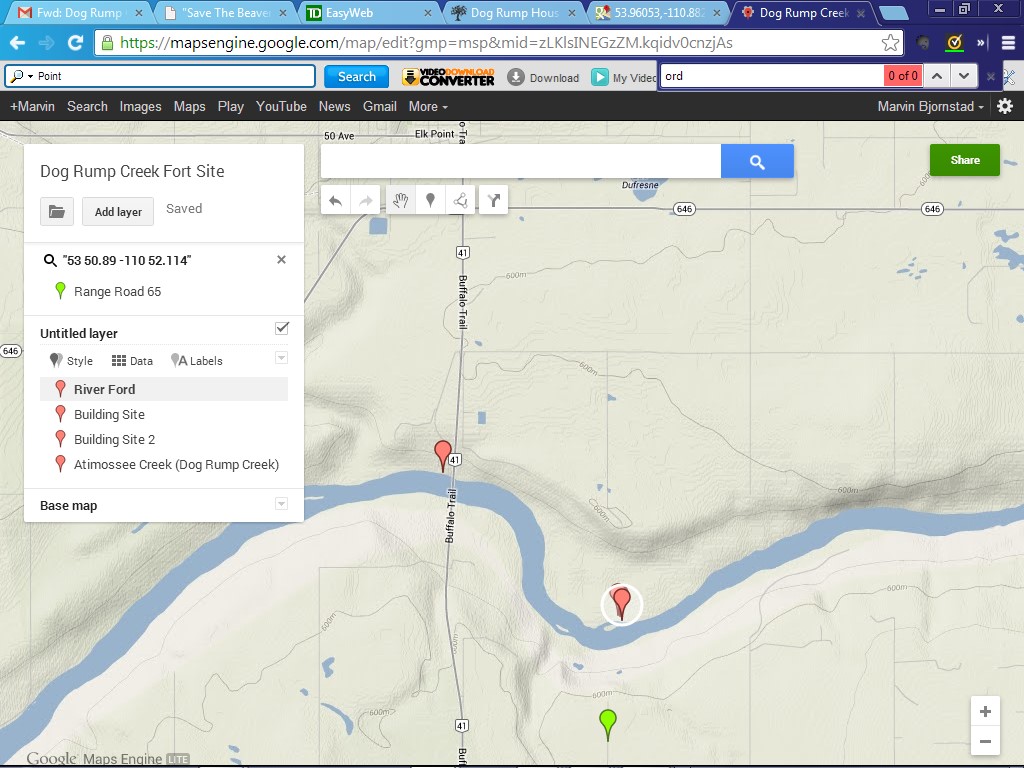About 2001, Ron Onusco and myself were working with Steve Andrishak on locating where he had found many artifacts about the fur trade. Steve lead us down to the flats below Glen Harms house on land originally homesteaded by the Bullis family (now part of Harvey Aarbo's lands). Here Steve showed us some depressions that were filled in after breaking where he had found beads and trinkets. He showed us a ford on the river which he said was why Dog Rump House was located there. Later research showed that the site might have done some trading in furs but was most likely a depot for meat which could be made into pemmican and shipped overland to the Beaver River Forts of the NWC as pemmican was a major food source for travelling long distances when traders did not want to take time to hunt while enroute to somewhere.
This map shows the GPS locations taken that day.

Here are the exact locations from the GPS.
|
Dog Rump House Buildings |
53 |
50.887 |
-110 |
52.074 |
05/21/2001 |
|
|
Dog Rump House buildings |
53 |
50.882 |
-110 |
52.119 |
05/21/2001 |
|
|
Dog Rump House Landing |
53 |
50.89 |
-110 |
52.114 |
05/21/2001 |
This is a further reference about Dog Rump House:
Thematic Study of the Fur Trade in the Canadian West : 1670 - 1870. -Terry Smythe
Prepared for: Historic Sites and Monuments Board of Canada - 1968.
182. Dog Rump Creek House
Location: North hank of Saskatchewan River, at mouth of Dog Rump (now Atimoswe) Creek, In about 5.25, Tp.56, R.7, W4
Dates: ante 1827
Founder: Unknown
Function: Probably wintering post
Nearest Community: Elk Point, Alberta
Background:
Edward Ermatinger's York Factory Express Journal for 1827-28 has the entry for 4 September, 1827: "Started about 4 o'clock and took breakfast at 10 at the
Old Fort below the Dog Rump Creek" The editor identifies this as Fort George, but there was another, presumably more recent post at this point, which is just a few miles above Fort George; for in 1830 John Rowand, at Edmonton, wrote to Simpson that he had "on my way from Carlton hither caused the men of the brigade to pull down the remaining buildings Stockheads &c. of Dog Hump Creek" .and had them carted
down to the place pointed out for the new Establishment." The new post was Fort Pitt (q.v.) The post demolished could not have been Fort George, since only the chimneys were standing in 1808. It must have been a post abandoned sometime in the 1820's, and cannot have been a major one.
Sources: Edward Ermatinger, York Factory Express Journal, C.O. Ermatinger, ed., Trans. R.S.C., Third Series, VI (1912), p. 102
R. Fleming, ed., Minutes of Council, p. 237n



